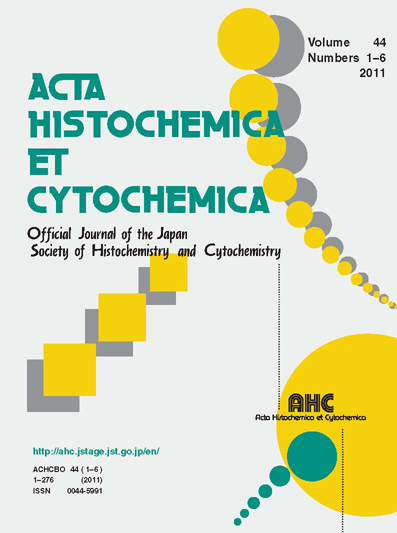
- Issue 6 Pages 167-
- Issue 5 Pages 137-
- Issue 4 Pages 129-
- Issue 3 Pages 101-
- Issue 2 Pages 63-
- Issue 1 Pages 1-
- |<
- <
- 1
- >
- >|
-
Yutaka TsutsumiArticle type: Review
2018 Volume 51 Issue 2 Pages 63-71
Published: April 27, 2018
Released on J-STAGE: April 27, 2018
Advance online publication: April 19, 2018JOURNAL FREE ACCESS FULL-TEXT HTMLIn the diagnostic pathology practice, specimens for electron microscopy (EM) are not necessarily handled and fixed under the ideal condition. In the present article, the author describes ultrastructural study using formalin-fixed and/or paraffin-embedded material. The fine morphologic preservation is often acceptable, particularly when small cubes are dug out of paraffin blocks. Particulate structures such as neuroendocrine granules and microbes are consistently observed even using paraffin sections. Paraffin sections signalized with silver particles in Grimelius and Grocott stains or diaminobenzidine products in immunostaining and in situ hybridization are applicable to EM evaluation by using a pre-embedding sequence. The practical merit includes the targeted approach: highly accurate sampling from focal lesions can be achieved for EM analysis, after observing hematoxylin and eosin-stained or specific-signalized paraffin-sections. This allows us pathologists a convenient and practical way for identifying focally infected pathogens, as well as a retrospective ultrastructural analysis of rare lesions long kept as a form of paraffin blocks.
View full abstractDownload PDF (1588K) Full view HTML
-
Yulin Chen, Yoshiaki Yamaguchi, Toru Suzuki, Masao Doi, Hitoshi Okamur ...Article type: Regular Article
2018 Volume 51 Issue 2 Pages 73-80
Published: April 27, 2018
Released on J-STAGE: April 27, 2018
Advance online publication: March 02, 2018JOURNAL FREE ACCESS FULL-TEXT HTMLJet-lag symptoms arise from temporal misalignment between the internal circadian clock and external solar time when traveling across multiple time zones. Light is known as a strong timing cue of the circadian clock. We here examined the effect of daily light on the process of jet lag by detecting c-Fos expression in the master clock neurons in the suprachiasmatic nucleus (SCN) under 8-hr phase-advanced jet lag condition. In WT mice, c-Fos-immunoreactivity was found at 1–2 hours on the first day after light/dark (LD) phase-advance. This induction was also observed on the second and third days, although their levels were diminished day by day. In contrast, c-Fos induction in the SCN of V1a–/–V1b–/– mice, which show virtually no jet lag symptoms even after 8-hr phase-advance, was only detected on the first day. These results indicate that external light has affected SCN neuronal activity for 3 days after LD phase-advance in WT mice suggesting the continuous progress of activity change of SCN neurons under jet lag conditions. Noteworthy, limited c-Fos induction in V1a–/–V1b–/– SCN is also consistent with the rapid reentrainment of the SCN clock in mutant mice after 8-hr LD phase-advance.
View full abstractDownload PDF (1478K) Full view HTML -
Yuji Tomori, Norio Iijima, Shuji Hinuma, Hirotaka Ishii, Ken Takumi, S ...Article type: Regular Article
2018 Volume 51 Issue 2 Pages 81-92
Published: April 27, 2018
Released on J-STAGE: April 27, 2018
Advance online publication: March 02, 2018JOURNAL FREE ACCESS FULL-TEXT HTMLLiposomes, artificial phospholipid vesicles, have been developed as a non-viral drug delivery system to allow contained agents to be efficiently delivered to target sites via systemic circulation. Liposomes have been used as a gene transfer tool with cultured cells; however, their precise trafficking and processing remain uncertain. Furthermore, liposomes with different surface charges are known to exhibit distinct properties. The purpose of the current study was to elucidate the intracellular trafficking and processing of liposomes with anionic and cationic surface charges from a morphological view point. We found that cationic liposomes (CLs) were more effectively taken by the cells than anionic liposomes (ALs). Confocal laser scanning microscopy and transmission electron microscopy demonstrated distinct intracellular localization and processing patterns of ALs and CLs. ALs and their contents were localized in lysosomes but not in cytosol, indicating that ALs are subjected to the endosome-lysosome system. In contrast, contents of CLs were distributed mainly in the cytosol. CLs appear to disturb the cell membrane and then collapse to release their contents into the cytosol. It is feasible that the contents of CLs enter the cytosol directly rather than via the endosome-lysosome system.
View full abstractDownload PDF (2331K) Full view HTML -
Jin Liu, Wenchang Zhang, Zhiren Wu, Lei Dai, Takehiko KojiArticle type: Regular Article
2018 Volume 51 Issue 2 Pages 93-100
Published: April 27, 2018
Released on J-STAGE: April 27, 2018
Advance online publication: April 24, 2018JOURNAL FREE ACCESS FULL-TEXT HTMLFor a better understanding of epigenetic regulation of cell differentiation, it is important to analyze DNA methylation at a specific site. In this study, we examined changes in the methylation level of CCGG and GATCG sites during mouse folliculogenesis in paraffin-embedded sections of mouse ovaries. For the purpose, we used a new method, histo endonuclease-linked detection of methylation sites of DNA (HELMET), designed to detect methylation sites of DNA with a specific sequence in a tissue section. Unlike the global level of DNA methylation, which was no change in immunohistochemical staining of 5-methylcytosine throughout folliculogenesis, we found that there were hypermethylation of CCGG and GATCG sites in most of the granulosa cells of tertiary follicles compared to that of primary and secondary follicles. Interestingly, TUNEL-positive granulosa cells, which were frequent in mammalian folliculogenesis, became markedly Hpa II-reactive and Sau3A I-reactive, indicating that the CCGG and GATCG sites may be preferentially demethylated during apoptosis.
View full abstractDownload PDF (1100K) Full view HTML
- |<
- <
- 1
- >
- >|